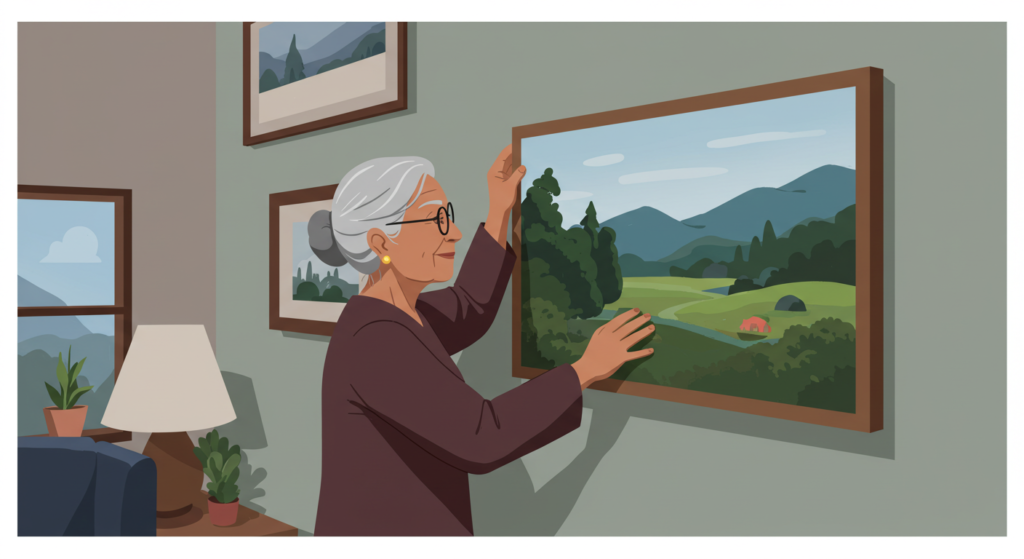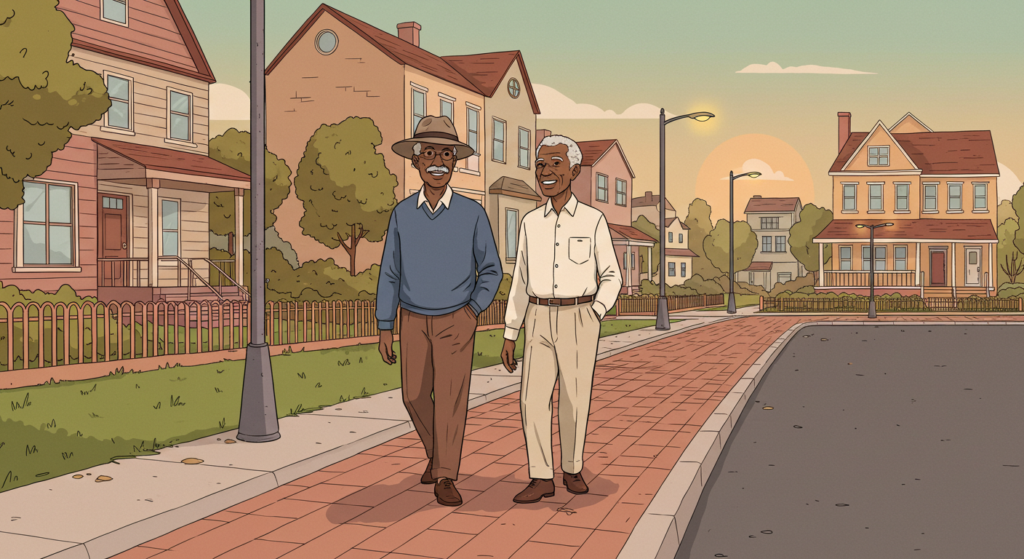
Your home is so much more than just walls and a roof—it’s where your life happens. The value isn’t just in square footage or equity. It’s in the comfort of familiar surroundings, spaces that “fit” your daily routine, and years of memories created within those walls.
Did you know there’s actually an entire field of study dedicated to understanding these powerful connections between older adults and their environments? It’s called environmental gerontology, and while that sounds like an academic mouthful, its insights are surprisingly practical when you’re trying to make housing decisions after retirement. Environmental gerontology and healthy aging go together like coffee and cream.☕️
At Silver Compass, we’ve woven these research-backed principles into how we help you navigate your housing options. This isn’t just about counting bedrooms or negotiating a fair price—it’s about understanding how your surroundings support your identity, independence, and well-being.
Let me give you a quick tour of some key themes from environmental gerontology that will give you valuable perspective for making more confident, fulfilling decisions about your next chapter.
Adjusting Your Environmental Fit: When Your Home Feels “Off”
Have you ever had that thought that your home just doesn’t “fit” you the way it used to or the way it should? Maybe it’s a weekly struggle with laundry baskets up and down stairs. Or the growing challenge of house and yard work. Or a bathroom that seems ripe for an accident. 😬
These aren’t just random annoyances—they’re clear signs of a changing relationship . . . between you and your home.
Environmental gerontology and healthy aging research shows that finding the right balance between environmental support and challenge is essential for maintaining independence and wellbeing.
Researchers think about homes on a spectrum from “too much” to “too little”: on one end is a home that’s too challenging (creating frustration and limiting independence), and on the other is one that’s not engaging enough (leading to boredom or even faster aging). Your ideal living situation should provide just the right balance of support and challenge.
When that balance is off, you feel what the experts call “environmental press”—that nagging understanding that your home is now creating more obstacles than opportunities.
The good news? You have options. Sometimes small, simple changes make a big difference. Love gardening but find kneeling increasingly difficult? Elevated planting beds might be the answer. Having trouble seeing light switches in the dark? Motion-sensor lighting throughout your home can dramatically reduce fall risk.
The big idea here is that your home isn’t static and unchangeable. It can be adapted, modified, or you can transition to a new one that better supports your changing needs. What matters most is how well your environment supports YOUR unique routines and priorities, not some generic checklist of “senior-friendly features.”
Place Attachment: How Home Environments Connect to Identity and Memory
What turns an unremarkable space into a meaningful place? Studies in environmental gerontology and healthy aging consistently demonstrate that meaningful connections to our living spaces contribute significantly to psychological wellbeing and quality of life.
That kitchen where you’ve prepared countless family meals, the garden you’ve carefully tended through the years, the front porch where you’ve greeted so many dear visitors—these places gradually develop layers of emotional meaning that become an extension of who you are.
This helps explain why housing decisions in later life can feel so significant. When you’re considering a move, you’re not just comparing different floor plans and locations—you’re wondering what it would mean to make a new space feel like “your place.”
There’s also that comforting familiarity that comes from knowing a place like the back of your hand. The academics call this feeling “insideness”. It’s navigating your home without thinking, knowing exactly where everything is. It’s understanding your neighborhood’s subtle rhythms—which neighbors are early risers, when the mail typically arrives, how the light changes through seasons.
Feeling insideness creates security and belonging that’s hard to measure but is at the very heart of well-being. But that doesn’t mean you should never change your environment. Even when making a significant move you can preserve some key parts of what makes one place special and transplant them in a new spot.
The trick is to identify and preserve the essence of ‘home’ in ways that resonate deeply with you. This might mean something as subtle as replicating the scent of your old home by using the same brand of candles or type of fresh flowers you always kept on the kitchen counter. It could mean bringing along the wind chime that hung outside your previous porch or recreating the arrangement of books on your shelves that feels familiar to you. Maybe it’s keeping that well-worn basket for keys and loose change in the same spot by the door, or setting up a small herb garden in your new kitchen window to echo the one you left behind.
Even small sensory cues, like the sound of a favorite clock ticking in the background or the texture of a well-loved throw blanket on your couch, can make a new space feel instantly more like ‘yours.’ These thoughtful touches—whether tied to memory, routine, or even smell—help bridge the gap between old and new, creating a sense of comfort and continuity.

The Environmental Gerontology Approach to Housing Transitions
Whether you’re modifying your current home or moving to a new one, you’re navigating a significant life transition that requires both practical and emotional flexibility. Research published in the Journal of Aging and the Environment shows that successful housing transitions involve a balance of preparation and adaptation.
On the practical side, these studies consistently find that older adults who actively participate in planning their housing changes report higher satisfaction regardless of the type of move they make.
On the emotional side, the key is finding a balance between past, present, and future. It’s not a simple choice between holding onto the past or making a complete break—it’s about determining which aspects of your home environment are essential to maintain and which changes might actually add something new and satisfying.
Transitions offer a valuable opportunity to let go of what no longer serves you. It can be psychologically liberating to openly acknowledge that certain features of your current home are limiting you or creating unnecessary stress. Give yourself permission to imagine what a more ideal home environment might look and feel like.
Regardless of your certainty that change will be good, adapting to a new home takes time and unfolds differently for each person. But understanding that this settling-in process is normal and gradual can help you approach it with the necessary patience and purpose.
Community Environments and Their Impact on Healthy Aging
While it’s natural to think of “home” as just your own private property – that cute house and yard behind the picket fence – successful aging involves a much broader ecosystem of places. A core principle of environmental gerontology and healthy aging is that our wellbeing depends not just on our immediate home environment, but on the broader community context. The walkability of your neighborhood, access to services nearby, and availability of social gathering spots all play crucial roles in your overall well-being.
Your ability to stay engaged and independent relies on having easy access to experiences well beyond your house. Basic features like safe sidewalks, good street lighting, transportation options, and nearby everyday conveniences—like grocery stores, pharmacies, and restaurants—can either expand or limit how you experience the world around you.
Certain neighborhood spots deserve special attention. Sociologists call them “third places”— where people naturally connect outside of home (“first place”) and work (“second place”). It could be the local coffee shop where the barista knows your order, the library where you go for book club, or the community garden where you meet kindred green-spirits and share growing tips.
These third places become increasingly important as we age, especially after retirement, as they provide opportunities for casual social interaction and community belonging without requiring formal commitments or planning.
As you consider a potential move, we encourage you to look beyond the property lines of each potential home.
- Can you walk to services, shops, or everyday conveniences?
- Is public transportation available?
- How close are your healthcare providers?
- Are there “third places” for social connection nearby?
- Are surrounding streets and sidewalks safe and accessible?
- Can you easily access green spaces and natural areas?
- What cultural and recreational opportunities are available nearby?
Even the most perfect home can feel isolating if it disconnects you from a community that enriches your life.

Applying Environmental Gerontology to Your Housing Decisions
The research is clear: your home environment directly impacts your happiness, health, and sense of self. But we don’t need science to tell us what we intuitively feel—that finding the right balance between comfort and engagement, familiarity and opportunity, makes all the difference as we age. By applying principles from environmental gerontology and healthy aging research, we can make housing decisions that truly support long-term well-being and satisfaction.
That’s why at Silver Compass, we blend this research with genuine curiosity about you. We want to know your daily routines, your personal history, the things that bring you joy, and the challenges you’d rather leave behind. The science gives us a framework, but you fill in the details that matter most.
We’ve seen firsthand how applying these environmental gerontology principles helps our clients make more confident decisions. What works beautifully for your neighbor might be completely wrong for you. It’s about creating a living situation that fits YOU like your favorite reading chair—comfortable, familiar, and perfectly suited to who you are.
Let’s Discuss Your Ideal Environment for Healthy Aging
Whether you’re actively planning a housing change or simply exploring options, understanding how environments shape us as we age can help you make choices that support not just your practical needs, but your overall wellbeing and joy in life.
And while reading about these ideas is helpful, nothing beats a conversation about your specific situation. How is your current environment supporting you? What could work better? What would your ideal living space look and feel like? Let’s find a time to talk soon.
Thanks for reading : )
Peter Lindberg
Senior Real Estate Specialist
Lead Broker – Silver Compass Property Group
503-806-4277






